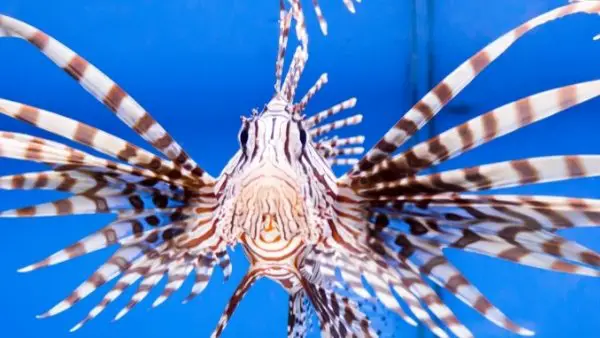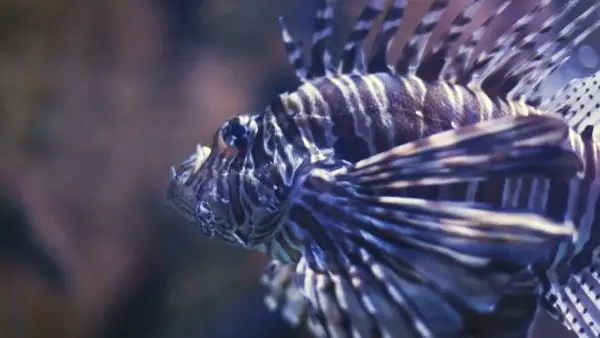Lionfish are fascinating fish and have been a massive part of the fishkeeping hobby for a number of years. They are carnivorous fish that are native to the Indo-Pacific region, however, over recent times they have become an invasive species to the Atlantic.
Regardless of the pros and cons, at some point in your hobbyist journey you will likely consider adding one of these mesmerizing scorpionfish to your saltwater fish community. This is why we have curated a list of 9 interesting facts about Lionfish that you simply won't want to miss!

9 Fun Facts About Lionfish
Lionfish are undoubtedly one of the most unique and fascinating fish you can add to your aquarium, and here are some fun facts that you have probably never heard about.
1. Lionfish Using Their Fins To Catch Prey
It is no secret that Lionfish are pretty relaxed, slow-moving creatures, which is why it comes as a surprise that they are such triumphant hunters, successfully catching and eating over 50 different fish species! Well, despite what many people think, they do not use their venomous spines as a weapon against their prey, instead, they use their pectoral fins to trap their future meals, before diving in and swallowing their prey whole, wow!
2. There Are Many Different Types of Lionfish
Many people assume that Lionfish are a sub-species from the Scorpionfish family, which is true, but there are actually over 12 different types of Lionfish, all with subtle size and aesthetic differences. Sure, they all look incredibly similar, but they are different, and typically hail from different oceans and regions around the world. The most commonly found Lionfish in the hobbyist world is the Red Lionfish (Pterois volitans).

3. Highly Venomous Spines
Most Lionfish species have a total of 18 potentially deadly spines attached to their bodies, more than capable of penetrating human skin and delivering an incredibly painful sting, fortunately, they are not fatal. 13 of the 18 spines are situated on the spine and dorsal fins, with a short spine on each edge of their pelvic fins, and 3 short spines on their anal fin. Fortunately, they do not try to deliberately penetrate humans or other fish with these spines, it is simply a defense mechanism, so it is your responsibility to watch out for them!
4. Considered an Invasive Species In The Wild
People releasing these beauties from home aquariums is just one giant cause of this Lionfish problem. They are considered an invasive species to the Western Atlantic Basin, where they are commonly found in abundance swimming in the Caribbean and South Florida waters. They have also invaded the Mediterranean Sea via the Suez Canal! So, getting yourself a Lionfish for your home aquarium is beneficial in more ways than one!
5. Female Lionfish Can Lay Up To 2 Million Eggs Annually
When Female Lionfish become sexually mature (reaching 7 to 8 inches or 1 year old) they will start releasing eggs, and a lot of them! A female can release a colossal 10,000 to 30,000 unfertilized eggs every 4 days, which is around 2 million per year! This is again, another issue that has caused them to become invasive because the population spreads like wildfire. Their egg sacs typically contain a chemical deterrent that discourages other fish from eating the eggs, smart, right?
6. Lionfish are Nocturnal Fish
Despite popular belief, Lionfish are nocturnal fish, meaning they prefer to go about their business during the night, rather than the day. This doesn't mean that you won't catch one gliding around your tank in the daytime, but it isn't all too common. They will actively hunt for food at night and be more active, even if the lights are dimmed and it is not a sunny day, you will see them swimming around "after hours".

7. Lionfish Tank Mates Are Possible
Lionfish are not known to be super aggressive fish, but they are predators and active hunters. So, it has always been recommended to keep them away from smaller saltwater tank mates. However, you can keep them with a whole host of compatible Lionfish tank mates. In fact, as long as your desired tank mate is roughly the same size or slightly bigger, can handle themselves, and has matching tank requirements you can 100% keep them in the same tank as Lionfish.
8. Lionfish Need a Large Tank
There are many different subspecies of lionfish that range in size and appearance, which is why it is important to acquire a tank size that is suitable for your lionfish. So, the dwarf lionfish subspecies, which consists of 4 different types require a 55 gallon (208 liters) aquarium or larger, if you are housing just one.

If you wish to keep more than one dwarf lionfish, you will need to ensure that they are both females or a mixed sex pairing and also that your tank is at least 75 gallons (284 liters) or larger. If you want a larger group of lionfish to reside in the same tank, you will be looking at 130 gallons (591 liters) +. Check out our graphic for a visual representation.
9. Their Coloration has been Adapted as a Warning
You may have noticed the incredibly vivid colors of red, white, and black that most lionfish sport, with the addition of striped patterns. This is not ideal for them avoiding predators as their coloration does not blend into the reef environments that they reside in. However, they have a trick up their sleeve.
They display a trait which is called aposematism, which means that they showcase visible features to warn predators away, letting them know that they are too dangerous to risk attacking. This is why their coloration appears so bright and is easily identifyable, not to mention that they become brighter when feeling threatened.
Final Words
After providing you with 9 Lionfish facts that you probably didn't know, you might now want to use this awesome knowledge to potentially own one yourself!

